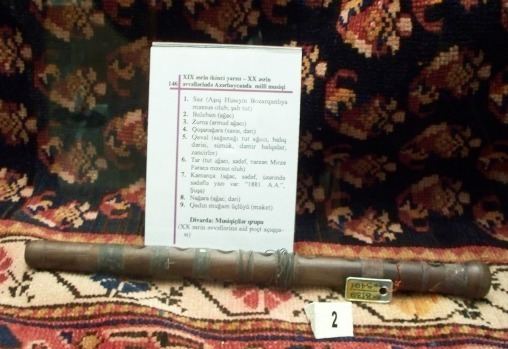Classification Woodwind | ||
 | ||
Balaban, or balaman (Azerbaijani: Balaban) is cylindrical-bore, double-reed wind instrument about 35 centimetres (14 in) long with eight finger holes and one thumb hole. This instrument is played in Iranian Azerbaijan and in the Republic of Azerbaijan. In Turkey it is called mey. The origins of this instrument come from Armenian Duduk, which looks very similar to it, but sounds quit little different.
Contents
Balaban can be made of mulberry or other harder woods, such as walnut. The bore through the instrument is about 1.5 centimetres (0.59 in) in diameter. The double reed is made out of a single tube of cane about six cm long and pressed flat at one end. The performer uses air stored in his cheeks to keep playing the balaban while he inhales air into his lungs. This “circular” breathing technique is commonly used with all the double-reed instruments in the Middle East.
Structure
The balaban consists of a stem, a reed, a regulator, and a cap.
The stem of the balaban, or govda, is a 280–320 millimetres (11–13 in) cylindrical tube made primarily of apricot wood (sometimes also hazel, pear, mulberry, boxwood, etc.). The process of carving a balaban stem is called balaban chakma. The upper end of the stem (bash or kup) is given a round shape, whereas the lower end (ayag) is sharpened. The bore is 10 millimetres (0.39 in) in diameter. Eight holes or "tones" constituting a "sound tone" (sas pardasi) are made on the obverse and another one is made on the bottom side, opposite of the interval between the first and the second holes of the sas pardasi. Sometimes an additional hole called nizam pardasi is made on the lower end of the bottom side to ensure good timbre.
The holes made on the stem are classified as follows:
The reed (gamish, garghy or dil) made of club-rush that grows in an arid area is inserted into the upper end. It flattens and takes the shape of a double reed. It is tied to a 60 millimetres (2.4 in) long and 10 millimetres (0.39 in) wide regulator (kharak, boghazlig, boyundurug, ulama, akma) made of a willow or grape branch cut lengthways. The reed is then fixed by a collar-like regulator on one side and a 7–12 millimetres (0.28–0.47 in) pivot on the other side. The cap (qapaq, aghizlig, kip, band, etc.) made of willow, hazel, cornel or mulberry is put on the reed to prevent it from damage. It is tied to the regulator in order not to be lost.
Use
On solemn occasions such as weddings and holiday ceremonies, a balaban-player is accompanied by a percussionist. A traditional Azeri musical group consisting of two balaban-players and a percussionist is called balabanchilar dastasi. In the past, the balaban was an essential musical element in the performance of mugham. It was also used in pastoral songs and funeral music. According to Huseyngulu Sarabski, hunters played the balaban to attract quails. Certain types of the balaban are also used in ashik music.
Legacy
Kamil Jalilov's recording of the song with balaban was included on the Voyager Golden Record, attached to the Voyager spacecraft as representing mugham, only Azerbaijani song included among many cultural achievements of humanity.
